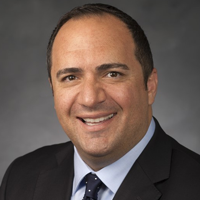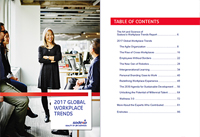An inside look at the UN Sustainable Development Goals
Interview with Aaron Sherinian, Chief Communications and Marketing Officer of the United Nations Foundation.
 Sodexo 2017 Global Workplace Trends Report is hot off the press with 10 major trends that will impact our workplace today and in the years to come. Today we sat down with Aaron Sherinian, Chief Communications and Marketing Officer of the United Nations Foundation to sum up the year following the launch of the organization’s SDGs.
Sodexo 2017 Global Workplace Trends Report is hot off the press with 10 major trends that will impact our workplace today and in the years to come. Today we sat down with Aaron Sherinian, Chief Communications and Marketing Officer of the United Nations Foundation to sum up the year following the launch of the organization’s SDGs.
Would you provide a bit of background on what went into creating the UN Sustainable Development Goals (SDGs)?
Aaron Sherinian: The UN Foundation has been involved with the SDGs not only since their adoption but also well before, during the inception and consultation. We were part of that very open political and consultative process of bringing together 190+ countries and defining the goals a year ago. The idea was to get the world talking about the goals themselves, to understand them and to help connect them to civil society groups across the planet.
An important aspect of the goals is that public input was solicited and they were essentially crowd sourced. At the time, one of the world’s largest surveys, the “My World” survey, asked people about their top priorities – such as education, healthcare, conservation, issues related to climate change, etc. And the goals were in part born out of this process.
What were some of the challenges involved in such a broad international approach?
A.S.: The fact that we launched 17 measureable targets around health, wellness, people and the planet required a bit of branding, so that corporations and organizations would want to align what they’re doing around some of these goals. We needed branding around them, not to make them clever, but to make them acceptable.
The SDGs are intentionally approachable so they can be just as easily understood by policy experts as by a person on the street, or a person in a boardroom. They are also intentionally multi-sectoral so that a great variety of organizations can attach themselves to the goals and work towards a larger plan at the same time. The only way we’re going to get to zero hunger is if everyone sees zero hunger as part of their day job. The only way we’re going to tackle climate change is if everyone sees climate change as part of their day job. The SDGs allow people to see this interconnectivity.
What major steps has the UN Foundation taken since the SDGs were agreed in September 2015?
A.S.: The UN Foundation has been very closely involved, supporting the community of partners who work with the UN in making sure that the goals were launched with considerable support in the corporate, public, media and civil society sectors.
The Foundation also measures everything we do against the SDGs, both in terms of raising awareness and in program investments. The goals also give us a set of concrete KPIs against which we can measure results – particularly in areas that many people, until recently, felt were intangible. There is now this idea that these things really matter to people in our society, so we must measure them. In short, we count what we measure and we measure what counts. And it’s encouraging as we’re now seeing more and more enterprising companies and NGOs coming up with platforms and measurement devices, providing different ways to measure progress on hunger and poverty, etc.
Have you begun to see organizations and companies that have already started to align their strategies with these goals?
A.S.: One of the most visible examples of a company really adopting these goals is Pfizer. They have not only begun linking their internal and external communications with the goals, but Pfizer literally covered its international headquarters in Manhattan with the SDGs. That sent an important message to their employees, their B2B partners and really anyone walking through their doors during the first six months after the launch.
At the same time, we’ve also seen faith groups from around the world using the global goals as a way to communicate to their pews. This is more than just Corporate Social Responsibility using the SDGs as a helpful platform, this is about people realizing that it tells a good story. If I care about malaria, how does that link up to a goal? If I care about underwater life, how does that link up to a broader set of targets?
Are the SDGs being adopted more quickly in certain types of organization? Or is there a wide diversity?
A.S.: I’m happy to see that the social entrepreneurial sector really gets it. Social entrepreneurs tend to live in an era where they know that measurement matters. For example, ENACTUS, the largest group of university student entrepreneurs in the world, retooled their entire competition around the goals. So whether you’re dealing with a student project or entrepreneurship project in another country, everything had to involve the goals.
Technology companies have also been particularly active. They understand that in the social media reality, you have to be able to talk to your customers and you have to have a sustainability story that is not tucked away in chapter 10 of your annual report. It needs to be part of your everyday feed. The short answer is that the savviest companies are the earliest adapters and they are moving ahead.
Any key takeaways when you look back over the past year?
A.S.: Goals of these kind make it clear that measurement isn’t a fad, it’s a way of getting things done in a smarter way. For example, when we launched the Millennial Development Goals (MDGs) back in 2000, there were moments when we knew we were behind on certain indicators and that allowed for the world community to come together and surge together. The UN, corporations and coalition groups united to get us back on track.
We need to use the SDGs, not only to talk about how well we’re doing, but also to point out where we need to do better or go faster, to measure progress. It’s not just about patting ourselves on the back, it’s about showing us where we need to be doing more.


